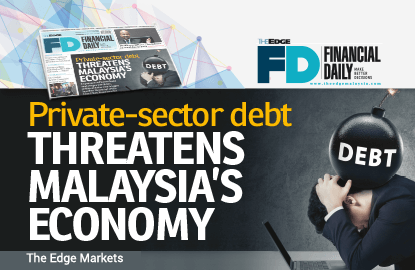
This article first appeared in The Edge Financial Daily, on May 31, 2016.
KUALA LUMPUR: An increase in Malaysia’s private-sector and corporate debt levels can give rise to another round of financial crisis, a political analyst said, in addition to political noise on the domestic front.
Citing a research by Japanese investment bank Nomura, Alavan Business Advisory Ltd co-founder and director Alastair Newton said while Malaysia’s economy is below the halfway mark of countries with a high risk of falling into another financial crisis, it is still deemed “vulnerable”.
According to him, Malaysia scored nine out of 20 marks. Higher marks indicate greater risk of a financial crisis.
“Something could spark somewhere else ... making Malaysia more vulnerable compared with other countries in the region,” he told The Edge Financial Daily on the sidelines of the SERC Global Economic Conference 2016 organised by the Associated Chinese Chambers of Commerce and Industry of Malaysia yesterday.
Earlier in his presentation entitled “Geopolitics is back”, Newton, a former senior political analyst at Nomura Securities Co Ltd, believes that unlike the 1997 Asian financial crisis triggered by high external debt, the next financial crisis in the region would probably be caused by increases in corporate and household debts.
“It is about private-sector debt and inflated asset prices caused by persistent ultra-low interest rates,” he said, adding that political instability would also affect the economy as seen in Hong Kong’s “Umbrella Revolution”, which impacted its stock market. Hong Kong stocks ended lower in 2014, amid protests demanding the right to freely elect their own leader.
Newton noted that in Asia (excluding Japan), China faces the biggest risk of a financial crisis, followed by Hong Kong, Thailand, Malaysia and Indonesia.
“If China does crash, Hong Kong may follow [too]. I don’t need to tell you how serious [it would be] if that were to happen,” he said.
Meanwhile, Newton said the financial scandal surrounding 1Malaysia Development Bhd does not pose a material risk to Malaysia’s financial stability yet.
“Investigations are still going on in countries such as Singapore, Switzerland and the United States. It is important to note that none of the investigations have even suggested that Prime Minister Datuk Seri Najib Razak or anybody close to him has been responsible,” he said.
“Whatever people may fear and suspect, the reality is that nothing has come to light to suggest that Malaysia should not trust its prime minister,” he added.
Malaysia’s debt-to-gross domestic product (GDP) ratio almost doubled from 2008 to 2015. According to Bank Negara Malaysia, the level of the household debt-to-GDP ratio continued to stay elevated at 89.1% amid more moderate growth in nominal GDP in 2015, making it one of the highest household debts in the region.
On the US presidential election of 2016, Newton said although Hilary Clinton is favoured to be the next US president by both polls and bookmakers, Donald Trump is closing the gap and could defy the odds by winning the White House.
“Forecasting Trump’s policies is hard, given the lack of substance in his campaign to date and his propensity to modify previous statements of intent,” he said.
Newton added that if Trump were to be the next US president, he could derail the Trans-Pacific Partnership and impose protectionist tariffs on, notably, Chinese imports.
Meanwhile, Newton expects Brent crude to remain rangebound between US$40 (RM164.40) and US$50 per barrel this year, barring any major supply-side shock.
“The recent shifts in Riyadh underline that [Deputy] Crown Prince Mohammad Salman is prepared to put politics, regional (Iran) and domestic (Vision 2030) ahead of short-term economic concerns in determining the kingdom’s policy on oil.
“My personal belief is that he would not want to see a sustained price above US$50 per barrel in the near to medium term, and would carry out his implicit threat to pump still more oil if necessary,” he said.